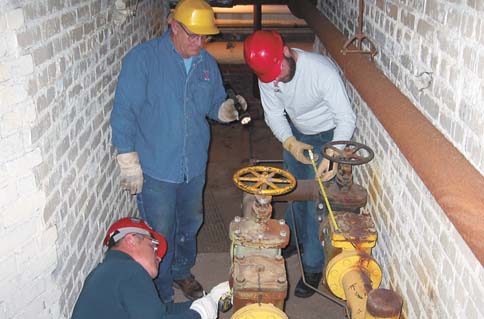| |
|
|

from the issue of January 29, 2004
|

| |
|
|
| |
Work underground helps save energy

BY KIRK CONGER, FACILITIES MANAGEMENT AND PLANNING/BUILDING SYSTEMS MAINTENANCE
Standing over one of the steam tunnel vents found on the grounds of the UNL campus may give you a warm, cozy feeling this time of year. But UNL Facilities Management and Planning is busy reducing this heat waste from steam pipes under campus.


 
| | Glenn Bear, center, and Charlie Griesen, right, of Utility Services help measure the valve of a steam pipe that runs under the campus for an insulation jacket. Facilities Management and Planning will add insulation to the pipes to reduce loss of steam and heat, which wastes energy and can be a safety hazard. The insulation is expected to save the university $135,000 a year in energy costs. At bottom is the contractor’s field engineer, Eugene Zlatov. Photo courtesy of Facilities Management and Planning.

| |
UNL’s utility plants produce steam ranging in temperature from 250-300 degrees Fahrenheit to heat campus buildings. Most of the pipes distributing this steam are insulated, but insulation on some expansion joints and other fittings has deteriorated over the years, and some pipes have never been insulated. Because of the high temperatures, heat loss through even a short length of uninsulated pipe is significant, so Facilities is replacing or installing new insulation where needed. Essential to this project are nearly 200 custom-made insulated jackets for odd-shaped pipe fittings, which can be removed and replaced for maintenance.

The steam escaping from underground pipes not only wastes energy and money, but it can be a safety hazard to utility plant employees. Those working in the underground tunnels can be severely burned if they touch an uninsulated metal pipe. The temperature in the tunnels also gets very warm and can cause dehydration or heat exhaustion. The added insulation prevents both of these problems by covering the pipes and keeping more heat inside the pipe.

Facilities engineers expect this insulation will save the utility budget $135,000 per year. The insulation repair, which will be completed this spring, will cost $180,000 and will pay for itself in about 16 months. The work is funded by the Nebraska Utilities Corp.

But because no thermal insulation is absolutely 100 percent effective, there will still be some warm air from the vents next winter.

Facilities Management & Planning has a number of other projects under way to reduce campus energy costs. For more information or to make a suggestion, contact Kirk Conger at .
GO TO: ISSUE OF JANUARY 29
NEWS HEADLINES FOR JANUARY 29
New year brings some changes to W-2s
Work underground helps save energy
731609S116X
|
|
|
|
|
|
|
|